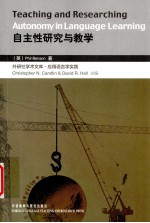

自主性研究与教学PDF电子书下载
- 电子书积分:11 积分如何计算积分?
- 作 者:(英)PHIL BENSON著
- 出 版 社:北京:外语教学与研究出版社
- 出版年份:2012
- ISBN:7560085296
- 页数:260 页
Introduction 1
Section Ⅰ:What is autonomy? 5
1 The history of autonomy in language learning 7
1.1 Origins of the concept 7
1.2 Autonomy and self-access 9
1.3 Autonomy and learner training 10
1.4 Autonomy and individualisation 11
1.5 Autonomy and interdependence 13
1.6 Why autonomy?Why now? 15
1.7 The two faces of autonomy 19
2 Autonomy beyond the field of language education 22
2.1 Educational reform 23
2.2 Adult education 33
2.3 The psychology of learning 35
2.4 Political philosophy 43
3 Defining and describing autonomy 47
3.1 Levels of control 48
3.2 Measuring autonomy 51
3.3 Autonomy and culture 55
4 Control as a natural attribute of learning 59
4.1 Self-management in learning 60
4.2 Learner agendas in the classroom 65
4.3 Control of psychological factors influencing learning 67
4.4 The seeds of autonomy 75
5 Levels of control 76
5.1 Control over learning management 76
5.2 Control over cognitive processes 86
5.3 Control over learning content 99
6 Conclusion 104
Section Ⅱ:Autonomy in practice 107
7 Fostering autonomy 109
8 Resource-based approaches 113
8.1 Self-access 113
8.2 Self-instruction and distance learning 131
8.3 The effectiveness of resource-based learning 133
9 Technology-based approaches 136
9.1 Computer-assisted language learning 137
9.2 The Internet 139
9.3 The effectiveness of technology-based approaches 140
10 Learner-based approaches 142
10.1 Learner development and language learning 144
10.2 Learner development and autonomy 146
10.3 The effectiveness of learner-based approaches 149
11 Classroom-based approaches 151
11.1 Planning classroom learning 152
11.2 Evaluating classroom learning 155
11.3 The nature of control in the classroom 159
11.4 The effectiveness of classroom-based approaches 161
12 Curriculum-based approaches 163
12.1 The process syllabus 164
12.2 Examples of curriculum-based approaches 165
12.3 The effectiveness of curriculum-based approaches 170
13 Teacher-based approaches 171
13.1 Teacher roles 172
13.2 Teacher autonomy 173
13.3 The effectiveness of teacher-based approaches 176
14 Conclusion 177
Section Ⅲ:Researching Autonomy 179
15 Research methods and key areas of research 181
15.1 Action research 181
15.2 Key areas of research 183
16 Case studies 193
16.1 Case study:ethnicity and attitudes towards autonomy 193
16.2 Case study:out-of-class learning 199
16.3 Case study:reflection 204
16.4 Case study:decision making in the process syllabus 208
16.5 Case study:language acquisition in autonomous classrooms 214
16.6 Case study:developing autonomy 220
17 Conclusion 224
Section Ⅳ:Resources 227
18 Resources for research and practice 229
18.1 Books,journals and newsletters 229
18.2 Conferences and workshops 230
18.3 Professional associations 230
18.4 E-mail lists 232
18.5 Web sites 232
18.6 Bibliographies 233
18.7 Self-access centres 234
References 236
Index 254
- 《红色旅游的社会效应研究》吴春焕著 2019
- 《汉语词汇知识与习得研究》邢红兵主编 2019
- 《生物质甘油共气化制氢基础研究》赵丽霞 2019
- 《东北民歌文化研究及艺术探析》(中国)杨清波 2019
- 《联吡啶基钌光敏染料的结构与性能的理论研究》李明霞 2019
- 《异质性条件下技术创新最优市场结构研究 以中国高技术产业为例》千慧雄 2019
- 《培智学校义务教育实验教科书教师教学用书 生活适应 二年级 上》人民教育出版社,课程教材研究所,特殊教育课程教材研究中心编著 2019
- 《《国语》和《战国策》词汇比较研究》陈长书著 2017
- 《中国制造业绿色供应链发展研究报告》中国电子信息产业发展研究院 2019
- 《指向核心素养 北京十一学校名师教学设计 英语 七年级 上 配人教版》周志英总主编 2019
- 《中风偏瘫 脑萎缩 痴呆 最新治疗原则与方法》孙作东著 2004
- 《水面舰艇编队作战运筹分析》谭安胜著 2009
- 《王蒙文集 新版 35 评点《红楼梦》 上》王蒙著 2020
- 《TED说话的力量 世界优秀演讲者的口才秘诀》(坦桑)阿卡什·P.卡里亚著 2019
- 《燕堂夜话》蒋忠和著 2019
- 《经久》静水边著 2019
- 《魔法销售台词》(美)埃尔默·惠勒著 2019
- 《微表情密码》(波)卡西亚·韦佐夫斯基,(波)帕特里克·韦佐夫斯基著 2019
- 《看书琐记与作文秘诀》鲁迅著 2019
- 《酒国》莫言著 2019
